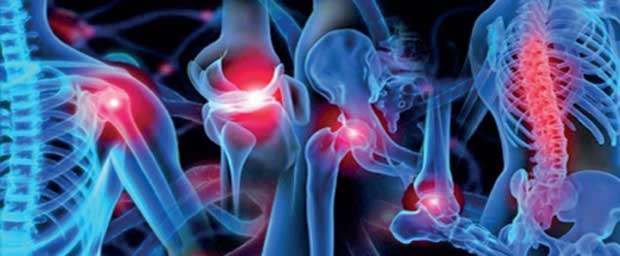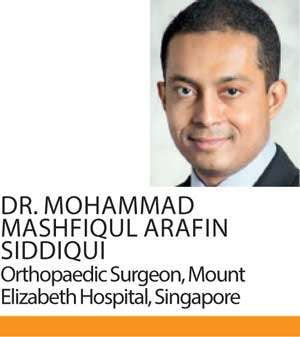Reply To:
Name - Reply Comment
medical malady

 An active lifestyle is part and parcel of healthy living. There is a certain group of diseases that affect the skeletal and muscular systems. These diseases negatively affect a person’s active lifestyle. From the most common condition of arthritis to the very rare aseptic osteonecrosis, these orthopaedic conditions greatly affect a person’s health and lifestyle. This week’s edition of Health Capsule features Dr. Mohammad Mashfiqul Arafin Siddiqui, Orthopaedic Surgeon, Mount Elizabeth Hospital, Singapore, who answered various questions that gloss over orthopaedic conditions in general.
An active lifestyle is part and parcel of healthy living. There is a certain group of diseases that affect the skeletal and muscular systems. These diseases negatively affect a person’s active lifestyle. From the most common condition of arthritis to the very rare aseptic osteonecrosis, these orthopaedic conditions greatly affect a person’s health and lifestyle. This week’s edition of Health Capsule features Dr. Mohammad Mashfiqul Arafin Siddiqui, Orthopaedic Surgeon, Mount Elizabeth Hospital, Singapore, who answered various questions that gloss over orthopaedic conditions in general.
“Orthopaedic diseases are very common among the ageing population. Complaints of muscle and joint aches that are more often heard indicate the increase in the incidents of orthopaedic cases. In addition, people are becoming increasingly aware of sports which especially contribute to orthopaedic injuries such as torn anterior cruciate ligaments (ACLs) in the knee joint,” Dr. Siddiqui stated. Considering Sri Lanka’s high interest in sports (especially in cricket and rugby), orthopaedic complications are definite threats. The more sports a person engages in, makes the individual more likely to be left without a guard against such health issues. In general, orthopaedic problems are quite common and according to the orthopaedic surgeon, it is very likely that its frequency would ascend further in future.
Not related to age
According to Dr. Siddiqui, back pains and knee pain spearhead as the most often contracted orthopaedic conditions. Knee pain is not just limited to the elderly. Surprisingly even young knees are susceptible to suffering from pain. “Osteoarthritis is the most common causative factor that leads to knee pain in adults. This is due to the wearing out and degeneration of cartilage in the knee joints. Mechanical pain on movement is often experienced. In young patients, the cause of knee pain varies from individual to individual depending on the activities they engage in. Sports injuries are most often the root cause for knee pain in the younger generation,” he explicated.
“The conditions of knee pain can be branched out as primary and secondary, where there is no particular cause for knee pain in the primary condition. Secondary complications could occur as the after effects of previous knee injuries and fractures, ACL injuries and previous surgeries for meniscectomy (surgical removal of the meniscus cartilage of the knee),” he continued, adding that inflammatory arthritis, gout and rheumatoid arthritis may also result in knee pains.
Signs and symptoms
Conditions like osteoarthritis are not very surprising in senior citizens, but is it possible to develop arthritis at a young age? The answer to that question is yes. Dr. Siddiqui mentioned that just like knee pain, the younger generation is under threat of other orthopaedic maladies. So although it is less common, a young person can develop osteoarthritis. “Total meniscectomy of the meniscus cartilage in young patients create circumstances where the patient is prone to falling victim to arthritis at a much younger age than the general population,” he informed. Previous sports injuries are to blame as well. X-rays are as good a method as any other to diagnose orthopaedic conditions like arthritis. When the elderly complain of the common orthopaedic symptoms such as joint aches, it is natural to suspect arthritis. Since arthritis and similar conditions are least likely suspected in children and teens, how are these anomalies detected in them ? When they complain of mechanical knee pain it is important to pay attention to the following symptoms. “Patients tend to feel pain in the front of the knee during movements; especially when going up or down the stairs. The range of knee movement would also be limited,” explained Dr. Siddiqui.
Variety in treatment

Obtaining treatment on time is important. Otherwise arthritis can lead to other conditions. “Valgus deformities can result from arthritis causing abnormalities such as malalignment of the knees,” he informed.
There are two methods of orthopaedic treatment. The non-operative and the operative method. “Non- operative treatment methods include activity modifications. For example, if a patient has to deal with a flight of stairs regularly, this activity would simply be changed to the use of an elevator. Activity modifications deal with similar scenarios. Physiotherapy helps strengthen different muscles in the legs. Medication as well as injections for early arthritis aids in treatment (injections are only temporary treatments). Weight loss is an important factor to consider,” he stated. The surgeon further accentuated that the body weight has a bearing on the knees. When a person performs an activity like running, jogging or even walking, this adds to the work load on the knees, increasing the pressure applied upon them. Weight loss helps minimize the pressure on the knees. Use of walking aids assist in reducing the force placed on the knees.
Operative treatments depend on the patient’s condition. “Pure arthritis in a young patient calls for realignment or replacement of the knee compartment. Sometimes just part of the knee is replaced whereas with more severe cases complete knee replacement is required. Sometimes a scope is performed where a camera is used as an aid to detect the defect. Sometimes meniscus tears could be the reason for the pain that is caused in the knee, but the condition could be misinterpreted as a different condition,” mentioned Dr. Siddiqui. He stressed that proper clinical diagnosis is vital. Therefore imaging is very important to confirm the condition properly. The cause of knee pains could be due to other reasons such as cancers and tumours.
Surgical risks and complications
There are bilateral cases that call for replacement of both knees in a patient. However not all patients are able to undergo such surgeries. Patients have to be carefully selected for such treatments based on whether they are able to tolerate certain conditions. The doctor warned that there are risks and complications that entail such surgeries. “Many orthopaedic procedures deal with implants. Therefore infection is a common risk as a foreign body is inserted through the implant. Limb surgeries may lead to deep vein thrombosis or DVT which is the formation of a blood clot in a particular vein which may cause immobilization of the limbs. Fractures as well as injury to nearby structures like nerves and blood vessels can occur during surgery. Paralysis is another risk feared by patients in relation to spinal surgeries,” he added. Long term planning is essential before surgical procedures are considered. According to the surgeon, the lifespan of a knee replacement lasts for around 15-20 years before a replacement is required again. Therefore a long term plan should be formulated with regard to the patient’s health before surgery is performed. “However today orthopaedic surgeries are quite safe with maximum recovery and the risks that entail are very low,” Dr. Siddiqui assured.